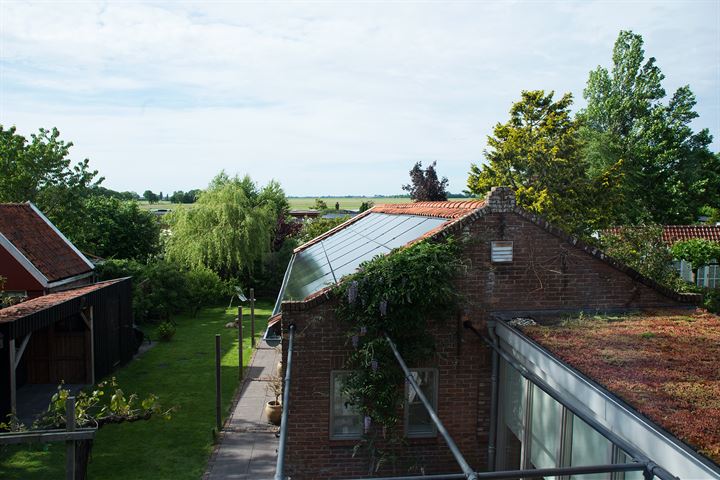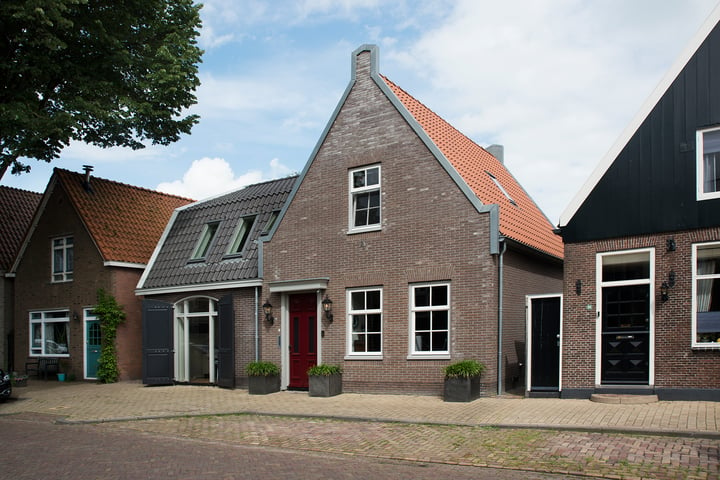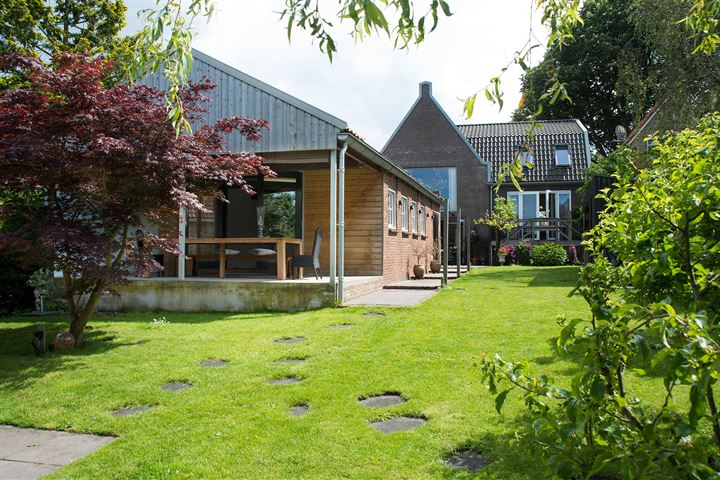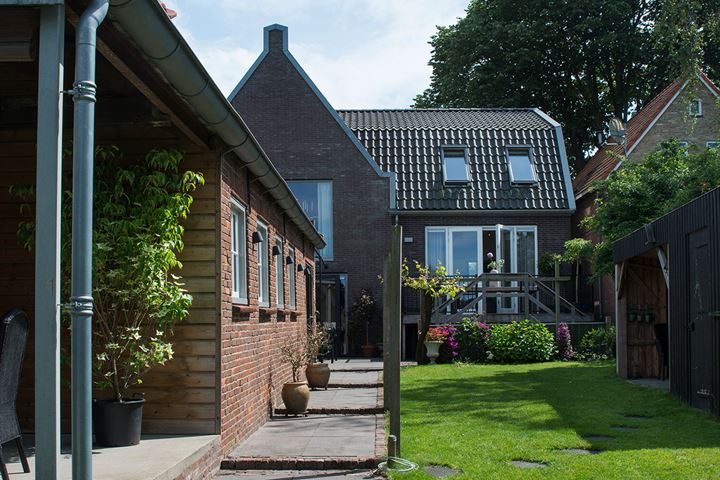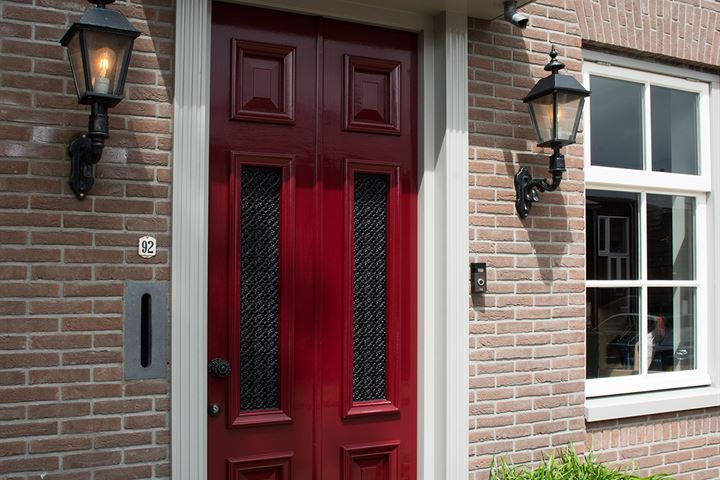Sales history
- Listed since
- June 6, 2024
- Date of sale
- July 5, 2024
- Term
- 4 weeks
Description
*** For English, please scroll below ***
‘Het Oare Gat’ - Oorgat 92, Edam.
In 1357 verleende graaf Willem V stadsrechten aan Edam. Wat aanvankelijk een daad van welwillendheid leek, was de-facto een strategische zet in de machtsstrijd tussen het grafelijk gezag en stedelijke regenten tijdens de Hoekse en Kabeljauwse twisten. Voor de Edamse burgers betekende dit meer rechtszekerheid, aangezien schout en schepenen nu zelf recht konden spreken, destijds bekend als 'dingen', waar ons huidige 'kort geding' van afgeleid is.
De verworven stadsrechten brachten privileges met zich mee die de bevolking van Edam voorspoed brachten en bijdroegen aan de economische bloei van de stad. In de daaropvolgende eeuwen bleef de vestingstad Edam gestaag in aanzien groeien, mede dankzij de scheepsbouw. Omstreeks 1560 telde de stad 28 werven waar Karvelen en Buizen werden gebouwd voor de koopvaardij en de haringvangst op volle zee.
Het succes van Edam manifesteerde zich in de overdadigheid van de 17e -eeuwse en vroeg 18e-eeuwse architectuur binnen de oude vesting. Een markant voorbeeld hiervan is het stadhuis, gebouwd door Jacob Jongh in 1737 aan het Damplein. Dit gebouw kreeg de uitstraling van een stadspaleis in Louis XIV-stijl, wat de Edamse elite zeer beviel: pompeus, symmetrisch, verheven boven het gewone.
In die tijd regeerde Lodewijk XV, de achterkleinzoon van de Zonnekoning, aan het Franse hof. De Franse Barok en de Louis XIV-stijl domineerden de Europese cultuur, en zo ook in de voorname vestingstad Edam. Het nieuwe stadhuis werd volledig in deze stijl gebouwd om grandeur en autoriteit uit te stralen. Vandaag is dit statige gebouw nog immer in gebruik voor huwelijksvoltrekkingen, en fungeert tevens als dependance van het Edams Museum.
Met de stadsrechten had Edam ook toestemming gekregen om een nieuwe haven naar zee te graven. Via de Voorhaven en het ‘Het Oare Gat’ (Oorgat) konden schepen nu rechtstreeks naar de Zuiderzee varen, een toemalige zeearm van de Noordzee, zonder de omweg via het Purmermeer.
De rijke geschiedenis van de stad Edam in Nederland is nauw verbonden met het historisch fenomeen Oorgat. De naam is afgeleid van het Nederlandse woord "oore", wat "oever" betekent, en "gat", wat "doorgang" of "opening" betekent.
Het Oorgat van Edam is nu niet meer in zijn oorspronkelijke vorm te vinden, omdat de Zuiderzee in de loop der tijd is ingepolderd en veranderd in het IJsselmeer. Desondanks herinnert de naam "Oorgat" aan het maritieme verleden van Edam en de belangrijke rol die de stad speelde in de Nederlandse handel en scheepvaart.
Het maritieme verleden van Edam zet zich tevens voort in de modernere architectuur. Vandaag staat aan Oorgat 92 een nagenoeg energieneutraal huis met energielabel A+++, geïnspireerd op de klassieke dijkwoningen die van origine aan het Oorgat werden gebouwd en vaak werden bewoond door zeelieden.
Door de ligging op verhoogde grond boden dijkwoningen veiligheid tegen hoogwater, waardoor ze ideaal waren voor waterrijke gebieden. De verhoogde ligging zorgt in het geval van Oorgat 92 voor een interessante dimensionele dans waarvan optimaal gebruik is gemaakt in het creëren van ruimte.
Het dimensionale karakter van dit familiehuis van ruim 250 M2 op een perceel van 580 M2 zorgt voor een beleving van licht en ruimte. Het huis werd opgeleverd in 2018 en gedeeltelijk gebouwd met hergebruik van de baksteen van de originele op het perceel gelegen dijkwoning. Er werd gebruik gemaakt van hoogwaardige materialen, volledige isolatie, een warmtepomp en 39 zonnepanelen. Vloerverwarming is aanwezig op alle verdiepingen.
Op straatniveau bevinden zich de entree, en een gastenappartement met separate entree. Daaronder bevindt zich de woonkeuken. De keuken heeft een directe open verbinding met de achterliggende tuinen en terrassen dankzij de aanwezigheid van grote glazen deuren.
Achter de keuken bevindt zich de voormalige schuur met loftachtig karakter, verbonden met het voorhuis middels een glazen pui en een met een eigen entree. Deze ruimte is te gebruiken als separaat gastenverblijf. Het heeft een eigen ingang, slaapkamer, badkamer en toegang tot de achterliggende veranda.
Op de eerste verdieping bevinden zich de zitkamer met panoramaraam en uitzicht over de rondom Edam gelegen landerijen. Een historisch landschap met oude wilgen en beknopte verkaveling. Daarboven bevinden zich de master bedroom met en-suite badkamer, twee additionele werk- of slaapkamers en een badkamer.
Rondom Het Oare Gat ligt een grote op het zuidwesten gelegen tuin met fruitbomen, volwassen beplanting en een mooie Japanse Esdoorn (Acer Palmatum). Een prettige tuin van 335 M2 in het centrum van de eeuwenoude vestingstad Edam.
Edam is gelegen op minder dan 27 kilometer van de Amsterdamse binnenstad. De haven van Edam bevindt zich op loopafstand van het huis, met directe toegang tot het Markermeer, ideaal voor zeilers, surfers en natuurliefhebbers.
Specificaties:
Bouwjaar: 2018
NEN-2580 gebruiksoppervlakte wonen: 250 M2
Perceeloppervlakte: 580 M2
Energielabel: A+++
Bruto inhoud: 1995 M3
Aantal slaapkamers: 5
Aantal badkamers: 4
Dubbele bewoning mogelijk: Ja
Bronnen:
[1] Edams Museum, B. Slot & R.J. Lammers;
[2] Historisch Genootschap ONH Noord Holland;
[3] Vereniging Oud Edam
Tekstuele samenstelling & vertalingen: Joep Hoogerwerf
Fotografie, visual & kleimaquette: Gloria Palmer
*******
‘Het Oare Gat’ - Oorgat 92, Edam, The Netherlands.
In 1357, Count William V granted city rights to Edam. What initially seemed an act of goodwill was, in fact, a strategic move in the power struggle between comital authority and urban regents during the Hook and Cod wars. The Hook and Cod wars comprise a series of wars and battles in the County of Holland between 1350 and 1490. Most of these wars were fought over the title of count of Holland, but some have argued that the underlying reason was because of the power struggle of the bourgeois in the cities against the ruling nobility.
For the citizens of Edam, this meant greater legal certainty, as the bailiff and aldermen could now administer justice themselves, a process then known as 'dingen,' from which our current term 'kort geding' (summary proceedings) is derived.
The acquired city rights brought privileges that bestowed prosperity upon the population of Edam and contributed to the economic flourishing of the city. In the following centuries, the fortified town of Edam continued to grow steadily in prominence, partly due to shipbuilding. Around 1560, the city boasted 28 yards where Carvels and Buizen were constructed for merchant shipping and herring fishing on the open sea.
The success of Edam was manifested in the opulence of its 17th and early 18th-century architecture within the old fortress. A notable example of this is the town hall, built by Jacob Jongh in 1737 on the Dam Square. This building was given the appearance of a city palace in the Louis XIV style, which greatly appealed to the Edam elite: grandiose, symmetrical, and elevated above the ordinary.
At that time, Louis XV, the great-grandson of the Sun King, ruled at the French court. The French Baroque and Louis XIV style dominated European culture, and so too in the distinguished fortified city of Edam. The new town hall was constructed entirely in this style to exude grandeur and authority. Today, this stately building is still used for weddings and also serves as an annex of the Edam Museum.
With the city rights, Edam also received permission to dig a new harbour leading to the sea. Through the Voorhaven and 'Het Oare Gat' (Oorgat), ships could now sail directly to the Zuiderzee, then a sea arm of the North Sea, without the detour via the Purmermeer.
The rich history of the city of Edam in the Netherlands is closely connected with the historical phenomenon of Oorgat. The name is derived from the Dutch words "oore," meaning "shore," and "gat," meaning "passage" or "opening."
The Oorgat of Edam is no longer to be found in its original form, as the Zuiderzee has been reclaimed over time and transformed into the IJsselmeer. Nevertheless, the name "Oorgat" reminds us of Edam's maritime past and the significant role the city played in Dutch trade and shipping.
Edam's maritime heritage also continues in more modern architecture. Today, at Oorgat 92, there stands a nearly energy-neutral house with an A+++ energy label, inspired by the classic dike houses originally built along the Oorgat and often inhabited by seafarers.
Due to their location on elevated ground, dike houses offered protection against high water, making them ideal for water-rich areas. In the case of Oorgat 92, the elevated position creates an intriguing dimensional play, which has been optimally utilized to create space.
The dimensional character of this family house, covering over 250 square metres on a plot of 580 square metres, provides an experience of light and space. The house was completed in 2018 and partially constructed with reused bricks from the original dike house on the site. High-quality materials were used, with full insulation, a heat pump, and 39 solar panels. Underfloor heating is present on all floors.
At street level are the entrance and a guest apartment with a separate entrance. Below that is the living kitchen. The kitchen has a direct open connection to the gardens and terraces behind it, thanks to the presence of large glass doors.
Behind the kitchen is the former barn with a loft-like character, connected to the front house by a glass wall and with its own entrance. This space can be used as a separate guest house. It has its own entrance, bedroom, bathroom, and access to the rear veranda.
On the first floor are the sitting room with a panoramic window and a view over the lands surrounding Edam. A historical landscape with old willows and compact parceling. Above that are the master bedroom with an en-suite bathroom, two additional study or bedrooms, and a bathroom.
Around Het Oare Gat is a large garden facing southwest, with fruit trees, mature planting, and a beautiful Japanese Maple (Acer Palmatum). A pleasant garden of 335 square metres in the centre of the centuries-old fortified town of Edam.
Edam is located less than 27 kilometres from the centre of Amsterdam. The harbour of Edam is within walking distance of the house, with direct access to the Markermeer, ideal for sailors, surfers, and nature lovers.
Specifications:
Year of construction: 2018
NEN-2580 usable area for living: 250 square metres
Plot area: 580 square metres
Energy label: A+++
Gross volume: 1995 cubic metres
Number of bedrooms: 5
Number of bathrooms: 4
Dual occupancy possible: Yes
Sources:
[1] Edams Museum, B. Slot & R.J. Lammers;
[2] Historisch Genootschap ONH Noord Holland;
[3] Vereniging Oud Edam
Text composition & translations: Joep Hoogerwerf
Photography, visual & clay model: Gloria Palmer
Features
Transfer of ownership
- Last asking price
- € 1,275,000 kosten koper
- Asking price per m²
- € 5,100
- Status
- Sold
Construction
- Kind of house
- Mansion, detached residential property (split-level residence)
- Building type
- Resale property
- Construction period
- 2011-2020
- Type of roof
- Combination roof covered with other and roof tiles
- Quality marks
- Energie Prestatie Advies
Surface areas and volume
- Areas
- Living area
- 250 m²
- Other space inside the building
- 5 m²
- Exterior space attached to the building
- 34 m²
- External storage space
- 5 m²
- Plot size
- 580 m²
- Volume in cubic meters
- 928 m³
Layout
- Number of rooms
- 11 rooms (5 bedrooms)
- Number of bath rooms
- 4 bathrooms and 1 separate toilet
- Bathroom facilities
- 3 walk-in showers, 4 toilets, 3 washstands, sink, double sink, and bath
- Number of stories
- 3 stories
- Facilities
- Skylight, optical fibre, mechanical ventilation, passive ventilation system, TV via cable, and solar panels
Energy
- Energy label
- Insulation
- Roof insulation, double glazing, insulated walls and floor insulation
- Heating
- Complete floor heating and heat pump
- Hot water
- Electrical boiler and solar collectors
Cadastral data
- EDAM B 954
- Cadastral map
- Area
- 580 m²
- Ownership situation
- Full ownership
Exterior space
- Location
- In centre, in residential district, rural and unobstructed view
- Garden
- Back garden
- Back garden
- 442 m² (34.00 metre deep and 13.00 metre wide)
- Garden location
- Located at the southwest with rear access
Storage space
- Shed / storage
- Detached wooden storage
- Facilities
- Electricity
Parking
- Type of parking facilities
- Public parking
Want to be informed about changes immediately?
Save this house as a favourite and receive an email if the price or status changes.
Popularity
0x
Viewed
0x
Saved
06/06/2024
On funda
